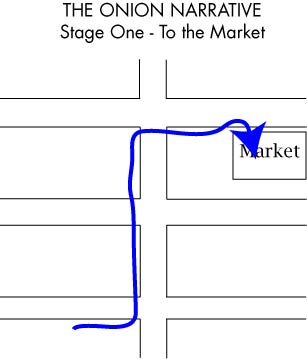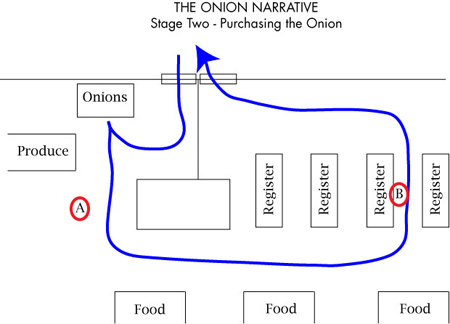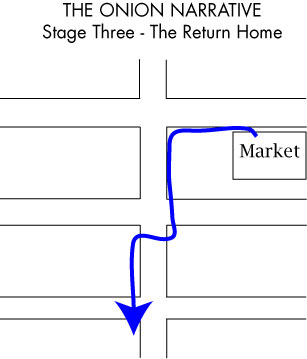On the morning of Saturday, March 21, 2009, I left the house to purchase an onion. This action, in and of itself, might be considered meaningless. Most would consider this a perfunctory deed or an insignificant errand. There isn’t a foolproof way to capture all comparable actions occurring at the same moment (9:30 AM EDT), but why should any of us ignore the potential pleasures contained within such a routine act? Are we taking this modern convenience for granted? Is a trip to the store to be sneered at? If we view a produce run with contempt, do we therefore view a previous age of humanity with contempt? Why should it have to be about us? A 10th century Viking berserking his way across North America certainly didn’t have this option of a neighborhood market. The Viking’s diet consisted of what he was able to hunt and gather. I am certain that if the Viking learned of developments eleven centuries later, common to every civilized being, and further ascertained that we were complaining about what a pain in the ass it was to get an onion so early in the morning (for the Viking surely had to spend half of his day plunging through the river for some fish), he’d put a battleaxe through our skulls. And we might very well deserve it. (At the risk of self-aggrandizement, let the record show that I did not complain.)
What I hope to document here is one such act, which I style “The Onion Narrative.” Because my effort to obtain this onion exists in the past, fixed and immalleable and further complicated by the mind tinkering even as it accounts for what happened. I have provided diagrams (certainly not to scale) that have divided my Onion Narrative into three tidy stages. And to demonstrate how imperfect this process is, as an experiment, I attempted to recreate my Onion Narrative on video, following the exact same walking route and purchasing yet another onion. My recollection of the details isn’t nearly as precise as I’d like to think. The video confirms that I overstated the width of the food aisles in my diagrams. For the diagrams, I used only memory as my guide. And the video camera placed additional limitations. I was forced to adjust the narrative circumstances contained within my memory. Because I was holding a camera, admittedly a small one, I was nevertheless required to take a dollar out of my wallet in advance so that I could hand it to the register clerk. This way, I wouldn’t have to set down the camera and extract the dinero from my leather pouch. In addition, the price of the onion was different from the initial price. The onion itself was different. Moreover, the social conditions surrounding my journey had drastically changed. (For one, there were more dog walkers.) I’ll explore the implication of these details very soon. But for the moment, let’s concentrate on the original narrative contained within my memory.
The Original Narrative
We needed the onion to make breakfast. We had run out of onions the night before because we had used the last one in our kitchen to make some homemade soup. The market was only blocks away from where we lived. The task offered an opportunity for me to walk. And I also found it somewhat comical that I would be going to the market for only one item. Just some commonplace produce that cost under a dollar. Was this bad time management on my part? After all, if you’re going to go to the store, shouldn’t you go there for multiple items so that you might save yourself some trips?
I did not see the situation that way. Here were my priorities for this five-minute excursion:
Priority One: Obtain onion.
Priority Two: Go for a walk, commune with the world, get away from the damn computer.
Priority Three: Find random opportunities for recurring curiosity about others to take root.
I willfully revolted against my first priority by purchasing not one onion, but three. It might be argued that by purchasing one onion, I had fulfilled my priority and that the two additional onions represented a new priority that I had whipped up on the spot; a spontaneity that I had not anticipated until I arrived at the onion bin. A more austere type might wish to punish me for my failure to obey the set dicta, or for not following the subconscious directions to the letter or for exceeding my budget, as ridiculously minuscule as it was. (For what it’s worth, I only purchased one onion when I recreated the incident.) I suppose it all depends on how much value you place on the onion or whether you feel comfortable having an extra onion around the house. Nearly anybody can afford an onion. Or at least nearly anybody lucky enough to have a roof over his head. And perhaps purchasing two extra onions doesn’t really matter if you have, as I did, even four dollars in your wallet. But if you only have a dollar and you purchase two more, then you are forced into a position of potential embarrassment when the clerk is forced to put the additional onions back. The second onion, beyond your means in this hypothetical case, determines your social position, which is very low indeed. But maybe you have no shame and you wish to max out your meager budget. Or maybe you want to see how the clerk will react to such a dilemma.
 As I progressed to the store (see the accompanying graph labeled Stage One), the first priority became less significant. I found myself considering the number of cigarette butts scattered on the sidewalk, which had proliferated considerably from last evening. This then led me to wonder if there was a higher percentage of smokers in my neighborhood than I originally estimated, or whether there were some people who who only liked to smoke on Friday night. But could I really make such a judgment when I wasn’t devoting my complete attention to how frequently the streets were cleaned or the people cleaning them? I then began to observe people as I walked. Over the course of my journey, I counted 31 people who were out and about.
As I progressed to the store (see the accompanying graph labeled Stage One), the first priority became less significant. I found myself considering the number of cigarette butts scattered on the sidewalk, which had proliferated considerably from last evening. This then led me to wonder if there was a higher percentage of smokers in my neighborhood than I originally estimated, or whether there were some people who who only liked to smoke on Friday night. But could I really make such a judgment when I wasn’t devoting my complete attention to how frequently the streets were cleaned or the people cleaning them? I then began to observe people as I walked. Over the course of my journey, I counted 31 people who were out and about.
31 people! And this was just over the course of five minutes. That’s 372 people in one hour, assuming that the rate of wanderers remains constant and that you don’t run into the same person twice. Given these numbers, small wonder then that we still obsess over the phenomenon of “running into someone.” And yet none of us, I think, are quite aware of just how many people we see or how many social or conversational possibilities we are presented with at any given time. We are often so fixated on our solitary task (in this case, the purchase of an onion) that we fail to consider our true insignificance.

Since I was in a jocular mood, I’d like to think that I plentifully partook of these social opportunities. But there were only two people with whom I had direct contact with. And this was in the store. (I do not count the dog with a sad-looking face just outside the store who angled his head through two metal railings for attention and who I proceeded to pet and speak in a soothing voice to.) At Point A: A boy saddling along with his mother and carrying a glum expression. Recognizing the boy’s need to feel happier, I stuck out my tongue at him, and he smiled. At Point B: Some banter with the register clerk. A “Good morning” and “How are you doing?” and a “Thanks.” A smile. But nothing beyond that. Indeed, at Point B in the video, I did even worse. My recreated journey on video sees me communicating with nobody save the clerk, and my socialization was limited to “Thanks.”
I felt like a terribly selfish person when these details were revealed. Had the video made me more self-conscious? Was I less jocular? Or were the circumstances inveterate? Can we be exonerated if we aren’t really aware of how few people we talk with? Or is it incumbent on us to be more socially responsible? If it is socially acceptable not to talk with even half of the 31 random people we regularly run into on any given day, then are we any less culpable in failing to live up to the possibilities before us? In 2007, a University of Melbourne researcher concluded that political candidates sitting on the left-hand position of a stage are more likely to draw attention. Because the brain, when tracking a tableau, has a tendency to drift to the left. I must note that in Points A and B that the individuals were to my left. I also see that my own journey to and from the store had me situated mostly on the left side of the street. Therefore, if my brain was going out of its way to excluding people, it was possibly because my visual cortex was occupied with the buildings and edifices. Was I subconsciously going out of my way to avoid people? (Additional factors to consider: I learned later in the afternoon that I was in need of social engagement. Several opportunities presented themselves and were taken.)
What is also troubling in my video reenactment is that the only time I comment on anything is when I see a bus parked at a stoplight. This bus is in almost the exact same position as another bus was during my original journey. And seeing the similarity, I am forced to violate the conditions of my recreation: commenting upon the action. This would further support the “running into someone” theory. Consider what cognitive scientist Colin Cherry identified as the cocktail party effect, whereby a person has the ability to focus in on one talker while a steady chatter of conversation is going on. This was supported last year by a study that revealed the auditory cortex does a good deal of work in filtering conversation. And if your brain has robust basal ganglia, well, then you likewise may have a robust “irrelevance filter.”
I do not know how tough my basal ganglia are. But I am troubled by how smoothly my brain deems certain details irrelevant. How little it notices. How needlessly egocentric it is on a subconscious level. After the fact, I am going out of my way to locate the new, the unseen, the underdogs, the moments I didn’t seize, the people I could have talked to, the emphases I now find phony or false.
 Stage Three of my journey seems less significant than the first two stages. By my own judgment, it is also the least interesting part of the video recreation. The onion has been obtained. I recall that during the original narrative, I found myself observing more people. I was not in a rush to get back. But on the video, I am circling around people rather than approaching them. I do not know if this is because of the camera or because I felt uneasy reproducing the narrative. And why should Stage Three be the least of the three? The primary goal has been obtained. The mind is at ease and can be more spontaneous with the rigid order out of the way. Or so one would think.
Stage Three of my journey seems less significant than the first two stages. By my own judgment, it is also the least interesting part of the video recreation. The onion has been obtained. I recall that during the original narrative, I found myself observing more people. I was not in a rush to get back. But on the video, I am circling around people rather than approaching them. I do not know if this is because of the camera or because I felt uneasy reproducing the narrative. And why should Stage Three be the least of the three? The primary goal has been obtained. The mind is at ease and can be more spontaneous with the rigid order out of the way. Or so one would think.
This exercise originated, in part, from ruminating over Roger Ebert’s recent post about the determinism of the universe, although the subject has long been on my mind. I am a secular type who does not believe in a deity, and yet, on some primordial level, my mind seeks to find connections and patterns. Even in thinking about why my mind reacted the way that it did, I am still trying to pinpoint a framework. How is this any different from Intelligent Design?
Among George Santayana’s great arsenal of pithy maxims is this one, written in response to William James’s the Varieties of Religious Experience: “Experience seems to most of us to lead to conclusions, but empiricism has sworn never to draw them.” I hope that I have been more explicit about my free will than James was, and yet I share with James a strange pleasure in vivisecting my experience. Of coming to terms with my subconscious limitations as a human being through diagrams and video reenactments. One should probably not approach life this way, because on a certain level, one must live with blind and uncomfortable truths. But is the truth really unraveled when we consider the structure beneath it? Or is the mind so hopelessly fallible, so determined in its determinist filtering, that human beings are doomed to repeat the same mistakes even when the horse has been led to water? This seems cynical rhetoric, but it’s quite liberating to know that, no matter how much you slice and dice up a moment, the mind remains a dutiful deflector.
